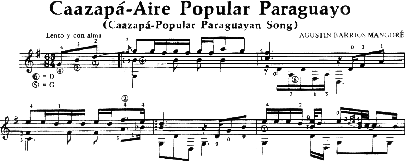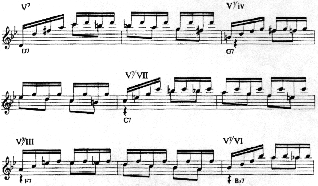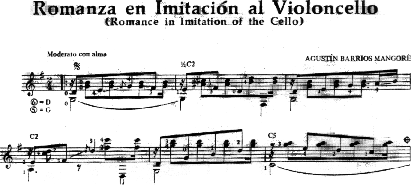Agustín Barrios Mangore:The Folkloric, Imitative, and the Religious Influence Behind His Compositions by Johnna Jeong

|
Agustín Barrios Mangoré:The Folkloric, Imitative, and the Religious Influence Behind His Compositionsby Johnna Jeong |
"... as a guitarist/composer, Barrios is the best of the lot, regardless of ear. His music is better formed, it's more poetic, it's more everything! And it's more of all those things in a timeless way. So I think he's a more significant composer than Sor or Guiliani, and more significant composer --- for the guitar --- than Villa-Lobos."
"Agustín Barrios Mangoré (b. May 5, 1885, d. August 7, 1944) was the greatest guitarist/composer of the first half of the present century." 2 Barrios was born into a large family in the small town of San Bautista de las Misiones, in Southern Paraguay, the fifth of seven sons. Both of his parents were educators and both placed great value on culture and arts. Inspired by his mother's guitar playing, Barrios began to play the guitar at a very young age.
Through the folk music of his native country, young Barrios received his first introduction to music; with songs such as the polca paraguaya, vals , and the zamba. In 1898, Barrios was formally introduced to the classical guitar repertoire by Gustovo Sosa Escalada. At that time, young Barrios had already composed works for the guitar, and also performed pieces written by his former teacher Alias, such as: La Chinita and La Perezosa. Under the influence of his new teacher, Barrios went on to perform and study the works of Tarraga, Vinas, Sor and Aguado. Sosa Escalada was so impressed with his new pupil, that he convinced Barrios' parents to let him move to Ascuncion to continue his education. 3 Having already surpassed the technical and performing abilities of most guitarists, Barrios began to seriously compose around 1905.
Three essential categories revealed in Barrios' compositions are folkloric, imitative, and religious. Barrios honored the music and the people of his native land and composed pieces modeled after folkloric songs of various countries of South America. Imitating composition and techniques form the Baroque and Romantic periods was another side to his craftsmanship. La Cathedral may be viewed upon as Barrios' imitation of Bach counterpoint. It is believed that La Cathedral was inspired by what may have been a religious experience for Barrios; therefore, the piece may also be categorized under religion. Religious beliefs and experiences also played an important role in Barrios' compositional process. Una limosna por el amor do Dio (An Alm for the Love of God), is another example of a religious inspired work. Breaking down the works of Barrios into these three categories helps aid the guitar enthusiast in the understanding of Barrios' musical intent.
Folkloric Aspects
The music of Barrios is reflective of many aspects of his life. He took great pride in his homeland, and many of his compositions were modeled after folkloric songs of various countries in South America. For example: he composed Choros, which is a from out of Rio de Janerio; Tangos originating in Argentina, Cuecos originating in Chile, and Danza Paraguayas, from Paraguay. Among his folkloric compositions, there are various regional dances; Danza Paraguaya No. 1 (c 1924), Danza Paraguaya No.2; Jha, Che Valle!, (c. 1923), and Danza Paraguaya No.3: London Carapé (c. 1909) exhibit some of his folkloric tributes to Paraguay. These three dances are based on Paraguayan rhythms and themes. The texture of Danza Paraguaya No.1 and No.2 is imitative of the Paraguayan folk harp. Folk harp music traditionally employs the galopa rhythm (Ex.1), and it is this rhythm that Barrios applies in Danzas No.1 and No.2. Jha Che Valle! (Danza Paraguaya No.2), is a phrase in the Guarani tongue (which is spoken more widely in Paraguay than Spanish) and means "Oh my homeland!" London Carapé (Little London), is a reference to nineteenth-century Asució. These lively pieces show yet another side to Barrios' multi-faceted musical personality. 4
Ex. 1: galopa (traditional Paraguayan rhythm): 5

Another example of how Barrios utilized rhythmic ideas of his native country is clearly illustrated in Caazapá is typical of Latin American music of Hispanic derivation. The meter alternates between 6/8 and 3/4 time, and occasionally moves toward polyrhythmic activity.
Ex 2: Illustration of a Paraguayan Popular Song and its alternation between 6/8 and 3/4:6

Imitative Abilities
Barrios' abilities did not only introduce his personal and innovative style, but he was also a master at imitating various eras and composers. "Barrios' compositional approach was eclectic, combining forms and harmonic devices from the Baroque, Classical and Romantic eras; often integrating them with popular forms and rhythms." 7 His music illustrates Romantic and Impressionistic characteristics, exampled by Un Sueno en la Floresta. This piece is a Romantic tremolo piece written in 1918, which expands the boundaries of tremolo composition with its intricate movement of inner voices and left-hand extension. To play this piece, Barrios had guitars made with an additional twentieth fret to accommodate the high C on the first string. Although common in today's guitar literature, this high C was unheard of prior to Barrios' work. 8
By 1919, while still in Brazil he composed Romanza en Imitació al Violoncello, Estudio de Concierto, Mazurka Apasionata, and Allegro Sinfónico. Analyzing the classics and transcribing for the guitar the works of Bach, Beethoven, Chopin, and Schumann, exerted a very strong influence upon his compositions during this time.
Barrios had a great love for the music of J. S. Bach. He had once stated, "How well Bach elevates us to the eternal".9 Many of his concerts consisted of his own transcriptions of the music of Bach. Transcribing the music of Bach for the guitar aided in his better understanding of the harmonic function of the pieces, and thus greater ability to compose in the style of Bach was attained. His Preludio Op. 5, No. 1 (in g minor) is an homage to Bach written in a baroque-like prelude form, making use of the concept of the pedal as illustrated in example 3. Barrios has successfully mastered the craft of imitating the music of J. S. Bach. The music of Bach, was written for instruments such as the cello, keyboard and lute and must be transcribed to the guitar, thus creating certain idiomatic problems. The one advantage of playing the music of Barrios, which was modeled after Bach, is that the music fits the guitar in a more comfortable manner. The music is written for the guitar, by a guitarist, and therefore is more attainable.
Ex. 3: Preludio ms. 72-80: 10

Barrios was fortunate to have studied the Aguado and Sor methodologies in his early years of training. Around 1917, he discovered the music of Tárrega and thereafter he began composing some of his best works. Some years later, Barrios wrote Variations on a Theme of Tárrega. "This work is undoubtedly one of the most technically demanding pieces. It explores many areas of guitar technique; arpeggios, scales, slurring, harmonics and tremolo. Paying homage to Tárrega's Lágrima, it consists of six variations that demonstrate Barrios' mastery of guitar technique and composition." 11 This piece portrays his most mature writing.
A standard piece in guitar repertoire is Prelude No. 1 in e minor by Heitor Villa-Lobos. This piece presents the melody primarily in the bass. A device borrowed from cello music is playing the melody in the bass register. Both Villa-Lobos and Barrios used this device in their compositions. However, Barrios elevated this device to perhaps its most complex level of conception and execution. Two of Barrios' pieces utilizing this approach are Confesión and Romanza en Imitación al Violoncello
Ex. 4: Romanza en Imitación al Violoncello ms. 1-6, (illustrating the melody in the base): 12

Religious and Cultural Influences
An exhilarating influence on many of Barrios' compositions is religion. At birth he was titled Agustín Pio Barrios, and from 1930 to his death he was recognized as Agustín Barrios Mangoré (Chief Nitsuga). In the year 1930, came the birth of Barrios' new persona, Cacique Nitsuga Mangoré, the "messenger of the Guarani race... the Paganini of the guitar from the jungles of Paraguay." 13
Disillusioned with his success, Barrios developed this persona in order to attract a greater audience and at the same time pay tribute to his forefathers. During this episode of performances by Chief Nitsuga, Barrios would dress in full Guarani tribal clothings (or lack thereof). "Barrios had no trouble drawing upon his roots to create the rather theatrical character of "Chief Nitsuga Mangoré"; it was a source of great satisfaction to him. "Nitsuga" is Agustin spelled backward, and the name "Mangoré" was taken from the historical figure of Chief Mangoré, leader of the Timbúes people, circa 1528." 14 August of 1930 is the first documented appearance of Barrios as Chief Nitsuga Mangoré, which was in Bahia, Brazil. "He was billed as " Agustín Barrios portraying the caricature of Nitsuga" indicating the beginning of a gradual transition which three years later would see him presenting himself exclusively s Nitsuga Mangoré with little mention whatsoever of Agustín Barrios." 15
This unique new persona did not however mark a new episode of compositional styles. It was during this spiritual escapade that Barrios wrote the Profesion de Fe (Profession of Faith), which explained from Guarani mythology, how Chief Nitsuga came to play the guitar, and how he ascended into his new persona:
Profession of Faith Tupa, the supreme spirit and protector of my people,
Found me one day in the middle of a greening forest,
Enraptured in the contemplation of Nature,
And he told me: "Take this mysterious box and reveal its secrets."
And enclosing within it all the songs of the birds of the jungle
And the mournful signs of the plants,
He abandoned it in my hands.
I took it and obeying Tupa's command I held it close to my heart.
Embracing it I passed many moons on the edge of a spring fountain
And one night, Yacy (the moon, our mother),
Reflected in the crystal liquid,
Feeling the sadness of my Indian soul,
Gave me six silver moonbeams
With which to discover its secrets.
And the miracle took Place:
From the bottom of the mysterious box,
There come forth a marvelous symphony
Of all the virgin voices of America." 16
Barrios' religious convictions were more theosophical than strict Catholicism. "For him God and Nature are inextricably part of one another, and Man, being part of Nature, is part of God. 17 A Brazilian newspaper, Jornal do Recife, published an interview on January 5, 1931 containing the thoughts and opinions of Barrios' views on religion:
"In spite of a severe religious education, my primitive pantheism has pointed me in the direction of Theosophy, the most human and rational of philosophic concepts. I believe in the immutable laws of Nature. And Humanity and the Good impregnate my spirit as the ethical end of all existence." 18
One great work that crosses the line between Imitative and Religiously inspired works is La Cathedral. This work is now one of his most widely played compositions. It consists of three movements: Andante Religioso, Allegro Solemne, and the Prelude which was written 19 years after the first two movements. "The story is related that he based this piece on an experience he had entering the Cathedral of San José in Montevideo; The broad, horizontal chords of the andante represent his impressions of the organist playing Bach in the cathedral. The ensuing allegro represents his leaving the calm, spiritual atmosphere of the cathedral and entering out into the street, where the hustle and bustle of the real world is represented by incessant 16th note arpeggio figures. 19 La Cathedral portrays elements of Bach counterpoint. This work is also one of his finest, exploring deep emotion and virtuosic technique.
During the later part of his life, Barrios composed Una Limosna por el Amor de Dios (An Alm for the Love of God). This piece is a tremolo composition, and displays Barrios' total mastery of this technique: the melody in the soprano voice is underpinned by an ostinato rhythmic motif in the middle voice.
Ex.5: An illustration of the bass motif in Una Limosna por el Amor de Dios: 20

"This motif, which is never altered during the piece and is said to represent the "knocking at the door" of a beggar, effectively bolsters the musical architecture." 21 Example 6 consists of measures 3-10 of An Alm for the Love of God, and displays the use of the ostinato rhythmic motif in lower voice in relation to melody in the soprano voice:
Ex.6: ms. 3-10 of An Alm for the Love of God 22

Barrios was a romantic, an idealist, and a humanist. "He intuitively recognized that there is a relationship between the good, the true and the beautiful and that all these realities are reflected in love towards life and one's fellow beings. Recognition of and resignation to these truths are powerfully expressed in the major key section of his last piece Una Limosna por el Amor de Dios -- the composition closes with a definite affirmation of these eternal values that Barrios achieved and manifested throughout his life: love being the process, and truth, beauty and goodness being the byproducts. 23 During the compositional process of Una Limosna por el amor de Dios, Barrios knew his end was near. After this final composition, Barrios spent his remaining days in tranquility, solace, and meditation, preparing himself for his own death. He began to suffer from heart trouble, and on August 7, 1944 he went into cardiac arrest and died. The priest who attended him proclaimed, "This is the first time I have witnessed the death of a Saint. 24
Barrios has clearly been one of the most underrated composers and players for the modern guitar. He was overshadowed by the work of Segovia and Villa-Lobos, even though his music was more virtuosic, more emotional, more skillfully conceived. "Barrios' music is very guitaristic, rather like Chopin is for the piano. In this way he has filled that need of every instrument to have its composer who "belonged" to the instrument and at the same time wrote great music." 25 His compositions are a revelation in the guitar repertoire. Always spontaneous, passionate, challenging, and true to the instrument. One may never tire of his versatility, artistry, and craftsmanship.
1Richard Stover, "Agustín Barrios Mangoré, His Life and Music Par IV: Discussion and Analysis," Guitar Review, No. 101 (Spring 1995): 24.
2 Agustín Barrios Mangoré, The Guitar Works of Agustín Barrios Mangoré, edited by Richard Stover, Vol. I (Belwin Mills, NY, Melville 1976): 2.
3 Richard Stover, "Agustín Barrios Mangoré, Part I; Youth in Paraguay," Guitar Review, No. 98 (Summer 1994): 1-6.
4 David Russell, "Music of Barrios David Russell, Guitar," CD, Telarc International Corporation, 1995.
5 Ibid.
6 Agustín Barrios Mangoré, The Guitar Works of Agustín Barrios Mangoré, edited by Richard Stover, Vol. II (Belwin Mills, NY, Melville 1977): 41.
7 Richard Stover , op. cit. 24.
8 Ibid. 25.
9 Richard Stover, Six Silver Moonbeams, "The Life and Times of Agustín Barrios Mangoré" (Clovis, CA: Querico Publications, 1992), 210.
10 Ibid. 211.
11 Ibid.
12 Agustín Barrios Mangoré, Vol. II op.cit. 44.
13 Richard Stover, "Agustín Barrios Mangoré, His Life and Music Part III: Cacique Nitsuga Mangoré" Guitar Review, No. 100 (Winter 1995): 17.
14 Ibid. 17.
15 Richard Stover, Six Silver Moonbeams, "The Life and Times of Agustín Barrios Mangoré" (Clovis, CA: Querico Publications, 1992), 111.
16 Richard Stover, "Agustín Barrios Mangoré, His Life and Music Part III: Cacique Nitsuga Mangoré" Guitar Review, No. 100 (Winter 1995): 17.
17 Richard Stover, Six Silver Moonbeams, "The Life and Times of Agustín Barrios Mangoré" (Clovis, CA: Querico Publications, 1992), 197.
18 Ibid. 197.
19 Ibid. 62.
20 Richard Stover, "Agustín Barrios Mangoré, His Life and Music Part IV: Discussion and Analysis" Guitar Review, No. 101 (Spring 1995): 26.
21 Ibid. 26.
22 Ibid. 26.
23 Richard Stover, Six Silver Moonbeams, "The Life and Times of Agustín Barrios Mangoré" (Clovis, CA: Querico Publications, 1992), 198.
24 Ibid. 174.
25 Ibid. 179.
famous guitarmaker internet world headquarters site maintained by cyboboy@cybozone.com
-
Read More
연주에 대해서...("존 윌리암스 스펙트럼"관련)(어쩌면여^^)
Date2003.10.12 By혁 Views6572 -
Read More
sadbird 라는 곡..
Date2003.10.12 By아따보이 Views5765 -
Read More
"콤파냐 보칼레" 연주회 후기...
Date2003.10.02 ByeveNam Views6009 -
Read More
나의 연탄 이중주에 대한 거짓말
Date2003.10.03 By으니 Views4829 -
Read More
망고레에 대하여~
Date2003.09.20 By혁 Views6873 -
Read More
공개질문입니다요~
Date2003.09.19 By기타사랑 Views7077 -
Read More
파가니니의 기타와 바이올린을 위한 대소나타[바이올린이 반주해주는] 좀 올려주세요.
Date2003.09.07 By메르츠 Views8625 -
Read More
로드리고의 곡들좀 감상실에 올려주십시오...
Date2003.09.06 By손님 Views4879 -
Read More
Cuban Landscape with Rain
Date2003.09.04 Byverve Views5567 -
Read More
★★★ 화음의 진행
Date2003.09.03 Bybluejay Views8420 -
Read More
J. S. BACH CHACONNE FROM PARTITA II, BWV 1004 - 제5부(참고문헌)
Date2003.09.02 By쩜쩜쩜 Views7733 -
Read More
J. S. BACH CHACONNE FROM PARTITA II, BWV 1004 - 제4부
Date2003.09.02 By쩜쩜쩜 Views7002 -
Read More
J. S. BACH CHACONNE FROM PARTITA II, BWV 1004 - 제3부
Date2003.09.02 By쩜쩜쩜 Views47960 -
Read More
J. S. BACH CHACONNE FROM PARTITA II, BWV 1004 - 제2부
Date2003.09.02 By쩜쩜쩜 Views7176 -
Read More
J. S. BACH CHACONNE FROM PARTITA II, BWV 1004 - 제1부
Date2003.09.02 By쩜쩜쩜 Views10406 -
Read More
[re] 나누어서 번역할 자원봉사 찾습니다.
Date2003.09.04 Bygmland Views5116 -
Read More
무뇌중 어록중에서.
Date2003.09.01 ByB612 Views8522 -
Read More
[re] 무뇌중 어록중에서.
Date2003.09.01 By천지대야망 Views6241 -
Read More
[re] 클래식은 리듬이 약하다는 논리에는 이견이 있습니다.
Date2003.09.01 Bygmland Views6129 -
Read More
전체적으로는 공감합니다만 약간...
Date2003.09.02 By오로라 Views4520 -
Read More
바하와 헨델, 바로크
Date2003.08.31 By천지대야망 Views6289 -
Read More
[re] 바하와 헨델, 바로크 - 약간의 딴지... ^^;
Date2003.09.01 By신동훈=eveNam Views4947 -
Read More
총평(디게 잼있어요)
Date2003.08.31 ByB612 Views4778 -
Read More
지극히 개인적인.
Date2003.08.31 ByB612 Views5336 -
Read More
음악의 호불호에도 객관적 보편타당성이 존재하는가?
Date2003.08.29 Bygmland Views4935 -
Read More
한국적인 것.
Date2003.08.29 ByB612 Views6960 -
Read More
[re] 조선의 힘
Date2003.08.29 By수 Views7413 -
Read More
음악에서의 호불호
Date2003.08.29 By수 Views6235 -
Read More
.
Date2003.08.27 By. Views5534 -
Read More
무척 혼란스럽습니다. 자중들 하십시오 !!!
Date2003.08.31 Bygmland Views5899 -
Read More
[re] 음악이 살아야 민족이 산다.(펌)
Date2003.08.29 By아롱이 Views5073 -
Read More
.
Date2003.08.28 By. Views5914 -
Read More
[re] 음악이 살아야 민족이 산다.(펌)
Date2003.08.29 ByB612 Views5098 -
Read More
[re] 음악이 살아야 민족이 산다.(펌)
Date2003.08.28 ByB612 Views4991 -
Read More
[re] 음악이 살아야 민족이 산다.(펌)
Date2003.08.28 ByB612 Views4701 -
Read More
Agustín Barrios Mangore:The Folkloric, Imitative, and the Religious Influence Behind His Compositions by Johnna Jeong
Date2003.08.14 By고정석 Views6630 -
Read More
[re] ★★★ 조국을 사랑한 바리오스 망고레 ( 글 & 번역 gmland ) 완결판 ★★★
Date2003.08.29 By고정석 Views8475 -
Read More
[re] ★★★ 조국을 사랑한 바리오스 망고레 ( 글 & 번역 gmland ) 완결판 ★★★
Date2003.09.16 By혁 Views5583 -
Read More
기타-화성학이란 무엇인가? - 예제를 통한 코드의 이해 (2)
Date2003.07.27 Bygmland Views9693 -
Read More
[re] 코드진행님 질문과 답변
Date2003.07.29 Bygmland Views4875 -
Read More
[re] 피날리 가진 분을 위한 피날리 악보 - 별첨
Date2003.07.27 Bygmland Views4961 -
Read More
이곡 제목 뭔지 아시는분?
Date2003.07.24 By차차 Views5653 -
Read More
Naxos 기타 컬렉션 中 명반은???
Date2003.07.24 By세곱이야 Views8222 -
Read More
기타-화성학이란 무엇인가? - 예제를 통한 코드의 이해 (1)
Date2003.07.24 Bygmland Views13678 -
Read More
또 질문 있습니다...^0^
Date2003.07.20 By아랑 Views6342 -
Read More
페르시안마켓에 대해서..
Date2003.07.19 By케텔비 Views8558 -
Read More
루이스 밀란의 파반느요..
Date2003.07.19 By루이스 Views4799 -
Read More
[re] 루이스 밀란의 파반느요..
Date2003.07.19 By루이스 Views4996 -
Read More
Guitar의 정의 - The Guitar
Date2003.07.18 By일랴나 Views5429 -
Read More
[re] Guitar의 정의 - 번역
Date2003.07.18 Bygmland Views4966 -
Read More
[펌] 피아졸라에 관한 글
Date2003.07.16 By삐아솔라 Views6590 -
Read More
멋있게 해석좀 해주세요..
Date2003.07.15 By아랑 Views6299 -
Read More
[re] 2001년 9월 1일자 외국어대 영자신문중에....
Date2003.07.18 Byseneka Views4885 -
Read More
[re] 채소님, 음악에 대한 인용구 번역입니다.
Date2003.07.16 Bygmland Views4703 -
Read More
Music Quotes..
Date2003.07.15 By채소 Views15661 -
Read More
퐁세의 발레토
Date2003.07.01 ByiBach Views5897 -
Read More
바루에꼬 마스터클래스 실황녹음(BWV996)
Date2003.06.29 ByiBach Views7247 -
Read More
장화음과 단화음의 비밀
Date2003.06.29 ByBluejay Views10179 -
Read More
[re] 7화음의 이름
Date2003.06.29 Bygmland Views6604 -
Read More
기타와 가장 잘 어울리는 악기는?
Date2003.06.27 By천지대야망 Views7687 -
Read More
기타 하모닉스에 관한 물리학적 접근
Date2003.06.23 By익제 Views5826 -
Read More
트레몰로.
Date2003.06.23 By수 Views4696 -
Read More
[re] 트레몰로.
Date2003.07.16 By기타 이상자 Views5475 -
Read More
바루에꼬 마스터클래스 실황녹음(아랑훼즈협주곡)
Date2003.06.21 ByiBach Views4887 -
Read More
바루에꼬 마스터클래스 참관기
Date2003.06.21 ByiBach Views5068 -
Read More
야마시타
Date2003.06.20 By천지대야망 Views5165 -
Read More
현대음악이란 이런걸 말하는게 아닐까요?
Date2003.06.19 By수 Views5835 -
Read More
음악도 분명히 현재의 모습을 반영하는 곡들이 지금가득합니다.
Date2003.06.23 Bycool Views4194 -
Read More
칼카시 토론을 하면서.......
Date2003.06.18 Bygmland Views4712 -
Read More
정규 소품은 연습곡이 되지 말아야 할 이유가 있을까요?
Date2003.06.17 Bygmland Views4696 -
Read More
토론실에 있는, 저작권에 대한 글들에 관하여
Date2003.06.14 Bygmland Views5129 -
Read More
음악의 예술성과 과학성, 음악과 음학
Date2003.06.11 Bygmland Views5808 -
Read More
코드...
Date2003.06.10 By얼떨결에지나가는넘 Views5166 -
Read More
마누엘 바루에꼬 마스터클래스(前記)
Date2003.06.10 ByiBach Views5269 -
Read More
★ Krystian Zimerman 마스터 클래스 후기 ★
Date2003.06.09 By으니 Views5430 -
Read More
카르카시 교본에 대하여....제 생각에는...^^;;
Date2003.06.07 By망고레 Views6415 -
Read More
제가 야마시타를 좋아하는 이유는,,,,
Date2003.06.06 Byseneka Views4772 -
Read More
카르카시교본비판에 관하여3
Date2003.06.04 By기타방랑자 Views4636 -
Read More
카르카시교본비판에 관하여2
Date2003.06.04 By기타방랑자 Views5097 -
Read More
제가 생각하는 카르카시.
Date2003.06.04 By아랑 Views5788 -
Read More
[re] '뺑뺑이' 얘기 나온 김에.....
Date2003.06.04 By아랑 Views4766 -
Read More
카르카시교본비판에 관하여
Date2003.06.03 By기타방랑자 Views5508 -
Read More
이것보쇼...
Date2003.06.04 By기타새디스트 Views4668 -
Read More
고수님들이 음악을 들을때요..
Date2003.05.31 Byshe Views4716 -
Read More
[re] 고수님들이 음악을 들을때요..
Date2003.05.31 Bycool Views4886 -
Read More
[re] 고수님들이 음악을 들을때요..
Date2003.05.31 By고수아님 Views4501 -
Read More
[re] 고수님들이 음악을 들을때요..
Date2003.05.31 By고수(?)임 Views4597 -
Read More
[카르카시비판]수많은 악플과 비판에 맞아죽기를 고대하며...
Date2003.05.29 By기타리새디스트 Views8100 -
Read More
고정도법과 이동도법 - 음명과 계명
Date2003.05.28 Bygmland Views8999 -
Read More
아람브라, 화성진행 및 프레이징 (3) - 총론 끝
Date2003.05.26 Bygmland Views5478 -
Read More
아람브라, 화성진행 및 프레이즈 분석과 프레이징 (2)
Date2003.05.23 Bygmland Views5500 -
Read More
[re] 질문입니다..
Date2003.05.27 Byseneka Views5756 -
Read More
아람브라, 화성진행 및 프레이즈 분석과 프레이징 (1)
Date2003.05.21 Bygmland Views8426 -
Read More
좋은 자료를 올리셨네요^^감사
Date2003.05.24 Bynarsis Views5286 -
Read More
프레이즈가 뭐지요?
Date2003.05.15 By바실리스크 Views6685 -
Read More
[re]프레이징을 어떤 수단으로써 어떻게 처리하나? (2) - she님의 질문에 대한 답글.
Date2003.05.19 Bygmland Views5102 -
Read More
[re] 프레이즈는 이 것입니다. (1)
Date2003.05.16 Bygmland Views4948 -
Read More
베토벤시대에 일반서민은 베토벤 만나기 힘들었다.
Date2003.05.13 By수 Views4811 -
Read More
요즘 누가 세고비아 듣느냐구요?? ㅠ_ㅠ
Date2003.05.14 By아랑 Views6339 -
Read More
[질문] 난해한 현대음악을 어떻게 들어야 할까요?
Date2003.05.12 By익명 Views4587
Designed by sketchbooks.co.kr / sketchbook5 board skin
Sketchbook5, 스케치북5
Sketchbook5, 스케치북5
Sketchbook5, 스케치북5
Sketchbook5, 스케치북5
